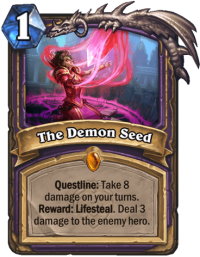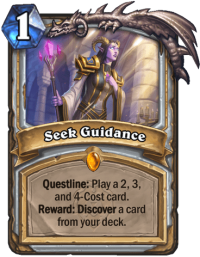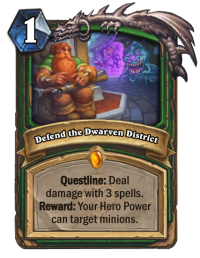Another expansion launch has come and gone, and yet, Questline Hunter still remains one of the strongest decks in the game, even at a time when the latest content release explicitly promotes a different kind of deckbuilding strategy. All other Questline archetypes have fallen by the wayside by now, yet Hunter’s still remains. Let’s dive into why that is the case and what this tells us about the game going forward.
United in Combo

United in Stormwind heavily and explicitly promoted combo-based strategies, and was so successful at it that multiple different Questline decks skyrocketed to the top of the winrate charts, prompting various nerfs. In the case of Mage and Warrior, the decks had to be adjusted multiple times.
This speaks to the inherent strength of the Questline mechanic. Starting out with the card in your hand greatly reduces the variance of your mulligan (which is an especially important part of generating unique game states in Hearthstone, since, unlike in Magic, your mana gain is consistent and reliable), and the repeated small rewards ensure a steady stream of resources (be it value or tempo depending on the specific Questline) as you progress towards your bomb.
Couple these facts with the highly limited number of disruption tools available in the game, and you’ve got a sure-fire recipe for success. For more on Quests and Questlines, you can check out an extended treatise here.
Defending the Dwarven District
So how does Hunter’s Questline stand out from the pack? What provided it with such longevity and flexibility to not only survive but thrive across a wide variety of different metagames? Not getting nerfed certainly helped, but that’s the effect, not the cause: the deck was strong but not oppressive, never reaching Team 5’s threshold of intervention.
There are multiple reasons for why the deck’s performed so well across the years. Unlike Mage’s Questline, the condition fulfillment aspect of Defend the Dwarven District is quite flexible. Casting any damage spell helps you along the way, and this allows the Questline Hunter deck to thrive regardless of the metagame. Against slower opponents, spell-based burn cards will progress you towards the reward, while the cheap removal tools on offer can help you against the more aggressive archetypes on the ladder.

The final reward also comes with the most brutal clock of all the Questline rewards, and it is interesting to compare and contrast it with Priest’s Purified Shard (Seek Guidance). Essentially, Hunter also gets a “destroy your opponent’s hero” effect once they complete Defend the Dwarven District, and once you factor in how Priest takes at least a couple of turns on average to draw into the reward, you’ll find that, with some exceptions, Rexxar can actually close out the game much more quickly. (And that doesn’t even factor in the fact that you will complete your Questline much faster on average as a Hunter than as a Priest – or most other classes, come to think of it.)
0 mana is always a super-slippery slope in Hearthstone and the effect has almost always been game-warping in one way or another. Questline Hunter is no exception to this rule, and a big part of why the deck is capable of turning games around so efficiently is that it can immediately make use of the 0-mana refreshing Hero Power once Tavish gets slammed onto the board, while all other classes tend to take at least one extra turn to refresh their mana total and take full advantage of the payoff.
The deck is quite similar to the old-school Razakus Priest – the combo between Raza the Chained and Shadowreaper Anduin worked very similarly to the current Quest Hunter, but even that was usually more difficult to pull off (not drawing one piece, having to get to 8 mana – Hunter gets it consistently every game and usually before 8 mana). And, as you might remember, Raza was nerfed to reduce the cost of Hero Power to 1 mana instead of 0, fixing the entire overpowered part of the deck.
Of course, none of this would matter if you could reliably aggro down the Questline Hunter decks, but therein lies the problem. The cheap and consistent spells on offer in multiple subsequent sets coupled with the synergies with Explosive Trap and, lately, Prince Renathal’s addition, makes it very difficult to close out the game before Questline Hunter gets its good stuff online. Hunter is more than happy to throw their cheap spells at your minions to stay healthy, before turning around and going for your face right after slamming down Tavish.
Also, a deck full of reactive cards is the one best-suited to skipping turn one (and to make use of the mulligan consistency), both of which are conditions that Questline Hunter easily fulfills. Unless it finally gets hit by the nerf bat, it is highly likely that it will remain among the best decks in the format until its eventual rotation to Wild.
The Future of Face Burn

Gone are the days of Mind Blast and Kill Command: the maturation of Hearthstone and the continued power creep means that singular “deal X damage to the face” cards are getting rarer and rarer. They are not efficient or interesting enough to print either, which means that burn effects are more and more often bundled with conditional text or as uncollectible rewards at the end of some sort of gameplay chain.
Expect more decks like Questline Hunter in the future and don’t be surprised if they also end up being there or thereabouts in power level, as long as a 0-mana element is involved: the fact that Hunter could get the job done with Steady Shot (and a history of poor control tools) shows that Team 5 is capable of shoehorning and bastardizing any archetype into existence with a strong enough support frame. Pure face decks are rare nowadays: you might like it or not, but Defend the Dwarven District, not Toxic Reinforcements, is the future of Hearthstone.
